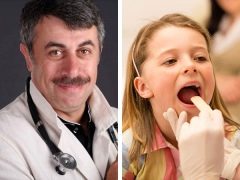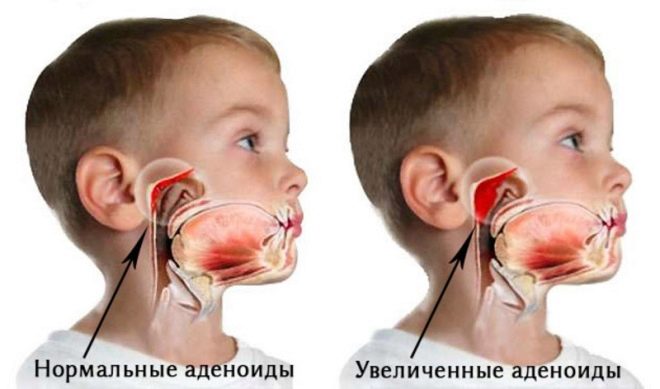Dr. Komarovsky on enlarged tonsils in a child
Sometimes at a pediatrician's appointment, parents hear that their child has tonsils. There are many questions why this is happening. But the attending doctor does not always have enough time to answer all the questions of each patient. And because the question was taken to clarify the famous pediatrician and TV presenter Yevgeny Komarovsky.
What are tonsils and why are they increasing?
Tonsils in medicine are called education, which consist of lymphoid tissue. This tissue is made up of cells of the immune system, which is known to perform protective functions. Lymphoid tissue is found in different parts of the body, but the tonsils are located in the mouth. That is why such a conclusion as “hypertrophy” is made by the pediatrician after he has examined the baby’s throat. These tonsils are called palatine, there is also a pharyngeal tonsil. People still call them “glands”.
Tonsils can simply increase, but they can also become inflamed. In the first case, they talk about hypertrophied tonsils, and in the second - about tonsillitis.
If the tonsils are clearly visible to the naked eye, then the pharyngeal can be considered only when examined by a doctor who uses special tools, since it is located near the posterior wall of the nasopharynx. It can also grow and inflame.
When this happens, the diagnosis sounds different: "adenoiditis" or simply "adenoids".
Palatine tonsils can grow and become inflamed for a variety of reasons. Most often this occurs during angina or chronic tonsillitis. The fact is that the mouth is an inlet, and the tonsils serve as border guards. If a virus or bacterium enters, the tonsils immediately respond to it with an increase, and sometimes inflammation, if the pathogen is present in large numbers.
The pharyngeal tonsil increases and begins to inflame for the same reason. But to see her without a special mirror, which the doctors use, is not possible. With adenoiditis, the pharyngeal tonsil does not decrease after an increase for the time of illness, it remains overgrown, it covers completely or partially nasal breathing.
If the doctor says that the child has loose tonsils, this also indicates contact with the virus, fungus or bacteria.
What symptoms to pay attention to?
With an increase and inflammation of the tonsils, parents themselves can easily see the child’s sore throat, enlarged tonsils, which turn red, on which ulcers can be observed in some forms of sore throat, and purulent plugs, white or yellowish plaque. As for the pharyngeal tonsil, it is also difficult to confuse here, if you know what symptoms are accompanied by adenoids.
Since the pharyngeal tonsil is located at the very base of the nasopharynx adjacent to the auditory tube, a child who has increased lymphoid tissue in this place will have a violation of nasal breathing and a decrease in auditory function.
Depending on how severe the symptoms are, three degrees of adenoiditis are distinguished: at the first, the nasal passages are almost a third closed and breathing is generally kept, as is the hearing, at 2 degrees the lumen is half closed, and at the third two thirds of miscalculation are blocked and the nose is almost impossible to breathe. There is a complete closure due to proliferation, in which nasal breathing is absent. In this case they also put the third degree, although some experts tend to call it the fourth.
The danger lies in the fact that the child begins to experience oxygen starvation due to an insufficient number of full breaths, he inhales through the mouth, the air does not warm up and is not moistened sufficiently, which increases the likelihood of bronchial and lung diseases.
The nose is swollen inside, there is stagnation in it, the child's voice becomes nasal. The frequency of otitis is increased and hearing is reduced. Even in a dream, the child continues to breathe with his mouth open.
If inflammation and an increase in palatine tonsils occurs at any age, then the pharyngeal is a typical children's problem, which mainly affects children from 4 to 7 years. It is at this age that the lymphoid tissue grows the most, but with age, as a rule, it decreases.
What to do?
What to do with enlarged and inflamed tonsils depends on why and how much they increased. The physiological reversible increase, which is often observed during a viral or catarrhal disease, as well as for some time after the baby’s illness, does not need treatment or other intervention. If your baby has a sore throat, be sure to undergo a course of antibiotic treatment, gargle, strengthen the child’s immunity so that tonsillitis does not become chronic. With chronically enlarged tonsils, surgical or total removal of the overgrown lymphoid tissue (tonsillectomy) is also practiced.
In the case of the pharyngeal tonsil, conservative treatment is possible with 1 and 1-2 transitional stages of the disease. In other cases, surgery is recommended - cutting or removing the tonsil (adenotomy). Komarovsky recommends treating adenoids with medicines, if the stage allows, to refrain from various folk and homeopathic remedies - the behavior of the lymphoid tissue and the consequences can be too unpredictable.
Conservative therapy prescribed by the attending physician. These are various vitamins and stimulants of children's immunity, means for washing the nose and drops with anti-inflammatory, antibacterial effect (if there is inflammation).
But if there is no effect or the stage is higher than the second, it is worth considering surgical treatment, not to abandon it. And the point is not exactly what stage, it is important how much the adenoids prevent the child from living normally. It also happens that with the first degree of the problem a decrease in hearing is observed, and then an operation is indicated.
Surgical treatment, says Yevgeny Komarovsky, is performed under both local and general anesthesia. It lasts no more than 3 minutes. There is nothing difficult in it, but the apparent simplicity should not be misleading about security. As well as after any other operation, complications, inadequate reaction of the child’s body to the administered anesthesia and nose bleeding are not excluded.
A well-known doctor advises to prepare for an operation - be examined, try not to get sick with colds and viral illnesses for at least a couple of months. Recovery takes place quickly - in a few days.
Komarovsky draws the attention of parents to the fact that it is impossible in principle to completely remove lymphoid tissue, and therefore there is always the likelihood of new growth.
Relapse prevention
First of all, says Evgeny Olegovich, after the operation, you need to change the lifestyle of the baby. Large tonsils do not occur only because of viruses and bacteria, there must be a predisposition to the disease. If you do not take into account heredity (which, by the way, plays an important role), the risk factors are pretty obvious:
- dusty dry air;
- reduced immunity;
- inhalation of chemical vapors, aerosols;
- low physical activity karapuz and poor nutrition.
To prevent the disease from returning, it is necessary to create conditions for the child to prevent the development of allergies, contact with chemicals, and house dust. Air at home should be sufficiently humid.
It is possible to increase immunity by playing sports, hardening, giving up weekends in front of a computer and replacing such leisure with family fun outdoors, active sports.
Dr. Komarovsky will tell you about when the children need to cut their tonsils in the next video.



















